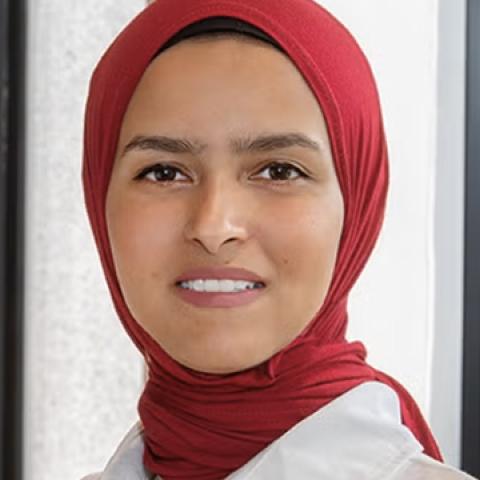A postdoc in the Department of Pharmacology at the School of Medicine, Mai Rashwan’s work is centered on understanding the intricate structure of cells at the molecular level—knowledge that could bring us closer to understanding diseases.
Leveraging the powerful imaging technique of cryogenic electron microscopy (Cryo-EM), Rashwan engineers gold nanoparticles to serve as contrast-enhancing agents under the guidance of her principal investigator Fang Chen. Her work builds on her doctoral studies in chemistry, which she completed at Case Western Reserve University. During her studies, Rashwan discovered insights into how the size, shape and surface chemistry of gold nanoparticles impacts their optical and photothermal properties.
Moving to the pharmacology department for her postdoctoral work has led Rashwan to focus her research more specifically on biological applications of her work.
Rashwan’s work has been met with considerable praise. She published three first-author papers during her doctoral studies, and presented at more than five national and regional conferences. At NASA’s Thermal and Fluids Analysis Workshop and the ACS Midwest-Mid Atlantic Regional Meeting in Cleveland, her presentations resulted in first-place honors. Additionally, she has more manuscripts forthcoming.
“These milestones reflect my growing expertise and commitment to advancing nanomaterials research at the interface of chemistry, biology, and medicine,” Rashwan said.
Learn more about Rashwan in a 2023 profile in The Daily and read about her postdoc career below.
1. What inspired you to pursue a career in this field?
My interest in this field stems from the research I conducted on nanoparticles during my PhD. Through this work, I developed a strong foundation in nanomaterials design and characterization. I was inspired to apply this expertise to the biological field, where I saw exciting opportunities to translate fundamental nanoscience into impactful biomedical applications.
2. Why did you decide to go into academia?
I’m passionate about research and discovery, and I see academia as the ideal environment to deepen my expertise, mentor future scientists, and contribute to advancing knowledge in my field.
3. What are your future career goals?
I aim to lead an independent research group in academia focused on the design and application of nanomaterials for high-resolution imaging and targeted drug delivery in biomedical systems. In parallel, I am deeply interested in contributing to interdisciplinary initiatives at agencies like NASA, where nanotechnology can be leveraged for advanced health monitoring, diagnostic systems, and materials innovation in space biology and exploration.
4. How have you gotten involved at CWRU?
I’ve collaborated across departments, mentored students, presented my work at university events, and supported international students adjusting to life at CWRU.
5. What advice do you have for fellow postdocs?
Stay curious, build strong collaborations, and don’t hesitate to seek support—from mentors, peers, or professional networks. Your growth comes from both success and challenges. All along with taking care of your health and family balance.


